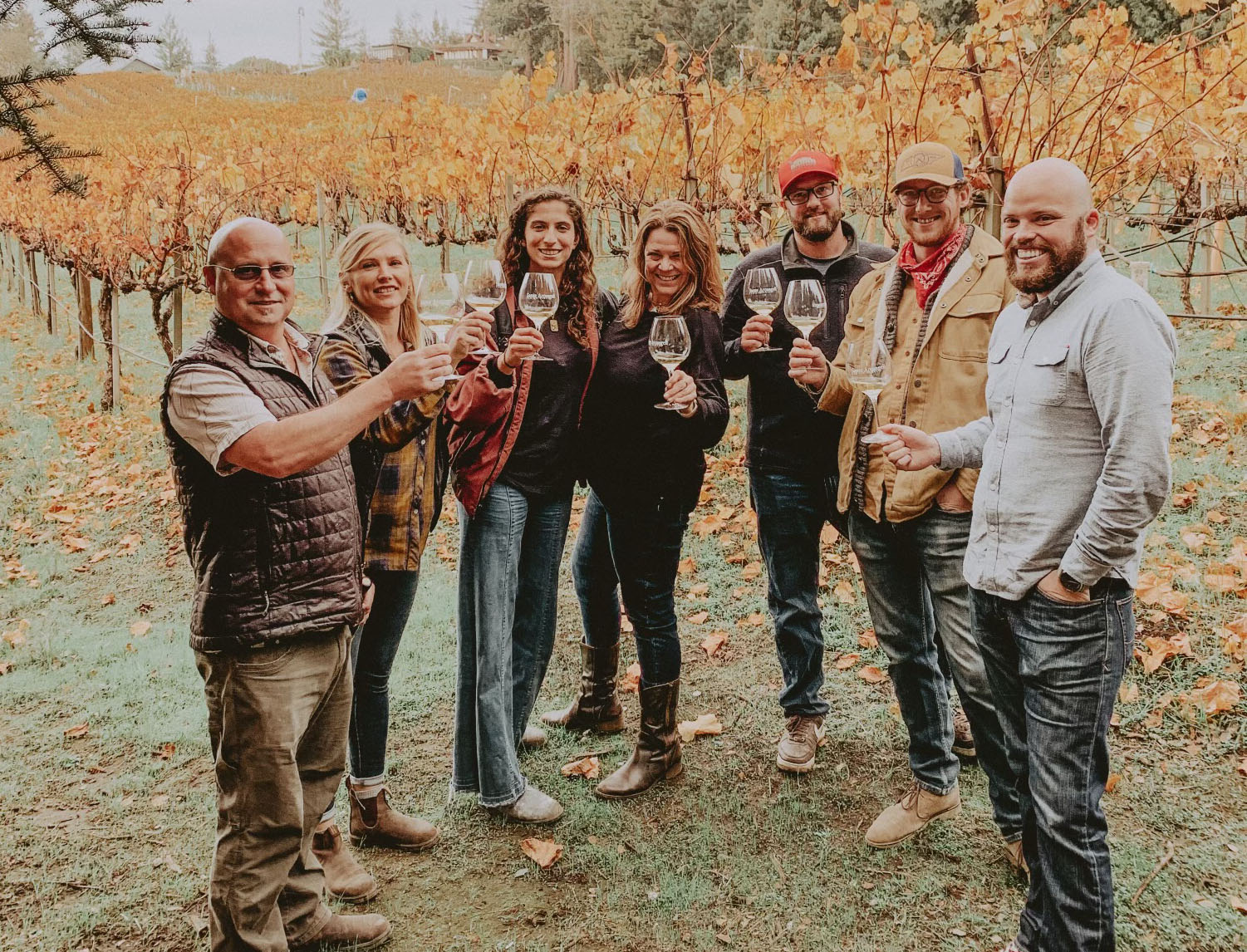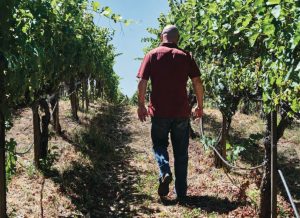Tariffs are in the news, to say the least. So much so that, if you’re like me, you’re getting sick of it all… the ups and downs, the pivots, the animosity, the crashing stock market… it’s enough to make anyone feel as if they’ve just shotgunned a box of wine and chased it with some Jaegermeister. Spinning, sickened and simply.. well… done.
The impact of tariffs on the US wine industry is going to be an evolving process of discovery, and much remains to be seen. My friend Ray Isle, of Food & Wine Magazine, has recently published a fantastic article about the wide-ranging impacts of these policies, and it’s a very worthwhile read. Using that as a starting point, I can tell you a few things about how this looks to a small, family-owned producer like me– and how it affects my longterm relationships with my suppliers, friends, customers and colleagues.
First off, high-end wine starts with a global partnership and goes nowhere without it. From the days of Paul Masson bringing over budwood from his friend in Burgundy, Louis Latour, to plant the first ever Pinot Noir vines in North America at his La Cresta Vineyard in Saratoga (aka Mountain Winery) to cork producers in Portugal (where all the natural corks in the world are made) to the unique and irreplaceable species of oak native to Europe that is required for the production of the world’s top Chardonnays and Pinot Noirs, this global partnership — that sometimes spans generations– is invaluable and essential. You simply cannot “buy American” when it comes to the oak used in your barrels if you want to produce elite-level Burgundian varietals. It must come from Quercus petraea or Quercus robur trees. Trees that are only grown for barrel production in Europe. And, pragmatically, even if we could… we’ve developed long friendships and often partnerships with these cooperages, who have advised us, nudged us along, and helped us make our wines better. Do we just drop them willy nilly? No. The importer– the barrel brokers, who are usually a US company, must pay the tariff on a barrel they have already purchased and paid for, as a lump sum payment, at the port of entry. And then they must ask me to pay them back for it when I buy the barrel from them. And I must pass the cost on to my customers or eat it. Personally, I’d rather eat dinner.
On the topic of American companies being hurt by this, let’s talk about those importers and distributors. Let’s say an importer of fine French wines– unique and incomparable wines that cannot be reproduced elsewhere– has made a deal with a producer in France to purchase a container of Burgundy for resale in America. He’s been offered an FOB (Freight on Board) price for the wines, has paid the producer, and the wine is in transit when a tariff is announced. Now, in order to get this wine off the boat, he has to come up with 20% more money, in a lump sum. As Ray states in his article:
Foreign wineries do not directly pay tariffs on wine exported to the U.S. Goods are not tariffed until they reach their U.S. port of entry. So it is the importer — a U.S. company with U.S. employees — that must pay the bill immediately. If $5,000,000 of wine arrives at a U.S. port that, as an importer, you’ve already bought and paid for, with a 20% tariff in place, that means a cash payment of $1,000,000, due immediately. If the importer can meet that payment, then, theoretically, you can recoup the money by raising prices. But in the end, who pays? In many ways, the U.S. consumer.
Does this importer simply end a sometimes multi-generation relationship with his producer in Burgundy and stop bringing some of the world’s most iconic wines into America because of one Presidential administration? I don’t think so. Instead, he has to raise the price.
What’s the drink in Idiocracy? Brawndo? Is that where we’re heading, where Brawndo is our only option as a beverage? Is that the goal here?
You might be thinking Well, wouldn’t French wine being cost-prohibitive be a good thing for American producers? If that was how it worked, you might be right. But that’s not how it works. When the importer moves the wine into distribution, he doesn’t want to hamstring the sales of his French wines and be stuck with it all– remember, he has already bought a whole lot of it. So he raises prices slightly on everything in his portfolio of wines as a way to offset the 20% increase in price for those international wines. And, you guessed it, his portfolio has a whole lot of American wines in it that will suddenly get more expensive to the consumer.
I’m using French wine as an example here, but tariffs will affect the import of wines from many other places: Australia, New Zealand, South America and the absolutely lovely wines of Canada. I, for one, am a huge fan of wines from Canada’s Okanagan Valley.
Speaking of Canada… who is (now was) the largest importer of American wines in the world? Oh, that would be Canada, our longtime friendly neighbor. With a nationwide boycott of American products in effect in Canada, what do you think that does to American wine distribution within the US? It becomes saturated with American wines that have no home all of a sudden. This is where we start talking about small producers like me.
There was a time when small, top-tier producers like me were sought after by distributors. By providing them with a relatively small amount of wine to sell, we leant “geek cred” to their portfolios: providing an alternative to the Josh or Meiomi that butters their bread, but which their more discerning customers scoff at. But now, faced with pressure from those large companies to keep sales of their products steady, the distributor must focus his/her attention away from the small producer in order to stay afloat, because those big boys suddenly have a lot more wine that needs to be sold in the US. This means that a small, high-end, family-owned business like mine must either find ways to sell everything direct-to-consumer (DTC) or be subjected to “bottom feeding” from the distributors: being asked to provide FOB pricing to them that is well-below what is sustainable for us. Remember: these guys have to find ways to offset the price increases they’ve had to put in place because of the tariffs on their imported wines. They’re not being evil, most of the time, it’s just what they have to do to survive in this increasingly hostile environment. The latter option of “fire sale” FOB pricing would have many of us out of business within two years.
Case in point: I recently offered a 96 point Pinot Noir to a distributor outside of California that I’d been working with for a couple of years. I offered it to them at $20/bottle, for them to retail at $40-49 in stores and $65 in restaurants. No deal. I had increased production of this wine solely for the reasons of cash flow, to satisfy this distributor’s needs and the needs of one other market outside of California. While I’d prefer to just sell all my wine locally, we need to sell some wine in big lots in order to pay for grapes, barrels, bottles (which are suddenly A LOT more expensive due to tariffs), etc. Those are commodities that we producers must pay for in lump sums. Selling one bottle at-a-time DTC does not meet the cash flow needs of continued production of wine. But… 96 points, $20/bottle and… no deal. Thanks… tariffs. The only way they’ll take that wine is if I offer a fire sale, because they suddenly have a lot more domestic wine that they have to find a way to move… at a higher price than before.
The point of all of this rambling is this: lots of businesses in the wine industry are hurting now, with small, family producers being at or near the top of that list. I don’t want to throw anyone under the bus here by recommending that you cut out the middle man entirely, but occasionally buying direct from the producer is a way for you, as a consumer, to support small producers, lest we vanish and your only options are the aforementioned “big boys”. Alternatively, maybe consider skipping the supermarket chain when you’re wine shopping and instead visiting your local wine shop, asking the proprietor if there is a smaller, independent producer that you should try out. Most of us, myself included, are now able to ship direct to many states. We can direct ship to 35 US states now, via our partnership with Vinoshipper. And, let’s face it, you don’t even have to get out of your bath robe to buy wine direct via our website. It’s not a bummer of an experience.
So give it a shot! That’s all I’m sayin’.
–JB




